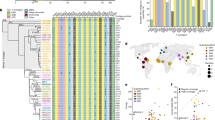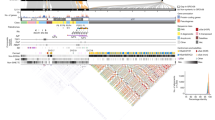Abstract
THE technique of in situ hybridisation of radioactively labelled DNA or RNA to the denatured DNA in metaphase chromosomes provides a powerful and popular method for identifying the chromosomal location of specific repeated DNA sequences1,2. In man, this technique has been used to map the ribosomal cistrons (ref. 3 and H.J.E., M. L. Pardue, and R.A.B., in preparation) and to examine the chromosomal location of three of the four known satellite DNAs4–8. Satellite II (ref. 6) was found in the centromeric hetero-chromatic regions (C band) of chromosome 1 and in the C bands of one C group (chromosome 9) and one E group chromosome pair (tentatively identified as chromosome 16). Satellite III (ref. 8) was found mainly in the C band of chromosome 9, with some in the centromere/short arm regions of the D and G group chromosomes, and possibly in the C bands of chromosomes 1 and 16. The satellite DNA investigated by Saunders et al.7 (which is probably identical to satellite IV of Corneo et al.5) was only positively identified in the C band of chromosome 9, although other regions of hybridisation were noted. In all these studies on satellite DNAs, the auto-radiographic observations were limited because no general chromosome identification was possible. Thus, only major sites of hybridisation could be detected and in some instances the locations of these sites were in doubt.
This is a preview of subscription content, access via your institution
Access options
Subscribe to this journal
Receive 51 print issues and online access
$199.00 per year
only $3.90 per issue
Buy this article
- Purchase on Springer Link
- Instant access to full article PDF
Prices may be subject to local taxes which are calculated during checkout
Similar content being viewed by others
References
Pardue, M. L., and Gall, J. G., Proc. natn. Acad. Sci. U.S.A., 64, 600 (1969).
Hennig, W., Hennig, I., and Stein, H., Chromosoma, 32, 31 (1970).
Henderson, A. S., Warburton, D., and Atwood, K. C., Proc. natn. Acad. Sci. U.S.A., 69, 3394 (1972).
Corneo, G., Ginelli, E., and Polli, E., J. molec. Biol., 48, 319 (1970).
Corneo, G., Zardi, L., and Polli, E., Biochim. biophys. Acta, 269, 201 (1972).
Jones, K. W., and Corneo, G., Nature new Biol., 233, 268 (1971).
Saunders, G. F., Hsu, T. C., Getz, M. J., Simes, E. L., and Arrighi, F. E., Nature new Biol., 236, 244 (1972).
Jones, K. W., Prosser, J., Corneo, G., and Ginelli, E., Chromosoma, 42, 445 (1973).
Ganner, E., and Evans, H. J., Chromosoma, 35, 326 (1971).
de la Chapelle, A., Schröder, J., Selander, R-K., and Stenstrand, K., Chromosoma, 42, 365 (1973).
Marmur, J., J. molec. Biol., 3, 208 (1961).
Author information
Authors and Affiliations
Rights and permissions
About this article
Cite this article
EVANS, H., GOSDEN, J., MITCHELL, A. et al. Location of human satellite DNAs on the Y chromosome. Nature 251, 346–347 (1974). https://doi.org/10.1038/251346a0
Issue Date:
DOI: https://doi.org/10.1038/251346a0
This article is cited by
-
Chromosomal polymorphisms associated with reproductive outcomes after IVF-ET
Journal of Assisted Reproduction and Genetics (2020)
-
Long Y chromosome is not a fetal loss risk
Journal of Assisted Reproduction and Genetics (2011)
-
Gene mapping and physical arrangements of human chromatin in transformed, hybrid cells: Fluorescent and autoradiographic in situ hybridization compared
Somatic Cell and Molecular Genetics (1986)
-
Heterochromatic regions on chromosomes 1, 9, 16, and Y in children with some disturbances occurring during embryo development
Human Genetics (1983)
Comments
By submitting a comment you agree to abide by our Terms and Community Guidelines. If you find something abusive or that does not comply with our terms or guidelines please flag it as inappropriate.



